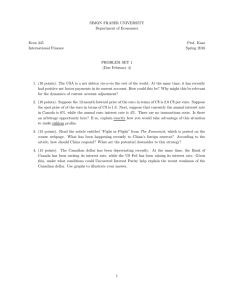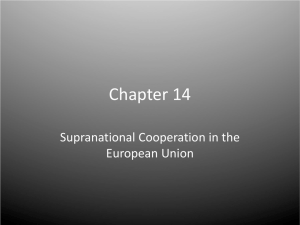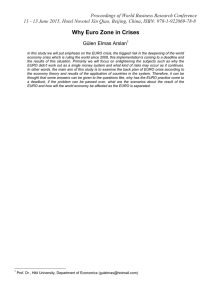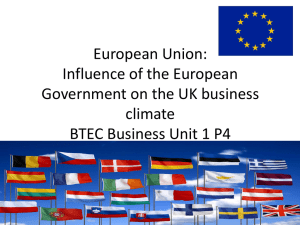ISSN: 2278-6236 IMPACT OF EURO ZONE CRISIS ON INDIAN ECONOMY
advertisement
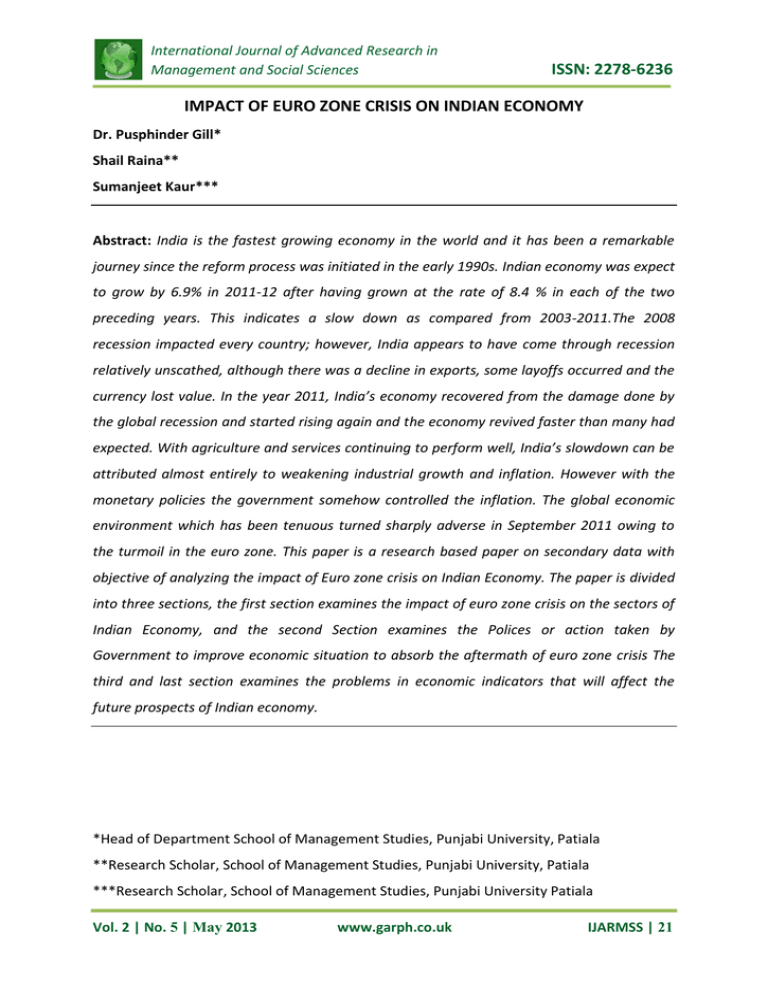
International Journal of Advanced Research in Management and Social Sciences ISSN: 2278-6236 IMPACT OF EURO ZONE CRISIS ON INDIAN ECONOMY Dr. Pusphinder Gill* Shail Raina** Sumanjeet Kaur*** Abstract: India is the fastest growing economy in the world and it has been a remarkable journey since the reform process was initiated in the early 1990s. Indian economy was expect to grow by 6.9% in 2011-12 after having grown at the rate of 8.4 % in each of the two preceding years. This indicates a slow down as compared from 2003-2011.The 2008 recession impacted every country; however, India appears to have come through recession relatively unscathed, although there was a decline in exports, some layoffs occurred and the currency lost value. In the year 2011, India’s economy recovered from the damage done by the global recession and started rising again and the economy revived faster than many had expected. With agriculture and services continuing to perform well, India’s slowdown can be attributed almost entirely to weakening industrial growth and inflation. However with the monetary policies the government somehow controlled the inflation. The global economic environment which has been tenuous turned sharply adverse in September 2011 owing to the turmoil in the euro zone. This paper is a research based paper on secondary data with objective of analyzing the impact of Euro zone crisis on Indian Economy. The paper is divided into three sections, the first section examines the impact of euro zone crisis on the sectors of Indian Economy, and the second Section examines the Polices or action taken by Government to improve economic situation to absorb the aftermath of euro zone crisis The third and last section examines the problems in economic indicators that will affect the future prospects of Indian economy. *Head of Department School of Management Studies, Punjabi University, Patiala **Research Scholar, School of Management Studies, Punjabi University, Patiala ***Research Scholar, School of Management Studies, Punjabi University Patiala Vol. 2 | No. 5 | May 2013 www.garph.co.uk IJARMSS | 21 International Journal of Advanced Research in Management and Social Sciences ISSN: 2278-6236 SECTION-I INTRODUCTION: The euro zone consists of Austria, Belgium Cyprus, Estonia, Finland, France, Germany, Greece, Luxembourg, Malta, the Netherlands, Portugal, Slovakia, Slovenia and Spain. Year 2010 saw the onset of European sovereign Debt crisis which is commonly called as euro zone crisis. There are four major causes for this crisis. First the rising government (public). The stability of the country can be determined by the percentage of government debt to its GDP. Greece is was in a very bad condition of public debt and next follow are Italy, Ireland, Portugal & Spain. The next cause of euro zone crisis was trade imbalance in terms of percentage GDP only Germany had positive trade balance and Spain, Portugal, Iceland Greece and Ital had negative trade balance. The third cause of the crisis was the structure of euro zone itself. The concept of structural problems, it is a monitory union but not a fiscal union. For stability of a currency system the member countries should follow same fiscal path since they don’t have a common path the countries follow their own fiscal policies. the last and fourth one is the monetary policy inflexibility a member country cannot print the money to pay to debit holders also ECB ( European Central bank) has inflation control mandate not unemployment mandate and the loss of confidence of investors in affected countries worsened the crisis. INTRODUCTION OF INDIAN ECONOMY: India economy is fourth largest economy of world with GDP of 4.457 Trillion USD as per PPP. After China Indian Economy is on rapid growth among emerging economies, it is an economy based on services. It is also seen as lucrative market. The sector wise break up of Indian economy is Agriculture 17.2 %, Industries 26.1% and services constitute 53.7%.Shown in Exhibit -1 Vol. 2 | No. 5 | May 2013 www.garph.co.uk IJARMSS | 22 International Journal of Advanced Research in Management and Social Sciences ISSN: 2278-6236 Exhibit -1 India is also facing the problems of government debt and maintains the balance of trade. The Government debt is about 68.53% of GDP (Exhibit-2) and Balance of trade has always been in deficit. Major portion of import, which India has, is crude oil. The foreign reserve in India is about 328 billion USD If we consider the industry structure the heavy industry are dominated by SOEs but they all are now opened for domestic private players so that the monopoly of SOEs can be removed and the competition will allow SOEs and Private players to improve. India government Supports entrepreneurship most, and then JVs with foreign Players. The reason behind this is that a small or medium enterprise provides much more employment. India is still relatively close to China when it comes to FDI, to boost its economy India can open the sectors that can attract foreign direct Investment. India has a major challenge of keeping economic growth with politics. India Government debt to GDP (%).Exhibit-2 Vol. 2 | No. 5 | May 2013 www.garph.co.uk IJARMSS | 23 International Journal of Advanced Research in Management and Social Sciences ISSN: 2278-6236 The major trade partners for India is European Union followed by China, since European Union is a major trade partner it accounts for close to 20% of India’s export and 13 percent of India’s imports. In 2010-11, European union countries imported roughly around USD 46.8 billion worth of agriculture product, machinery and transport equipment, chemical, semi manufactured products, textile and clothing product from India. As far as exports to India are concerned the EU exports to India amounted to USD 44.5 Billion. This largely constituted of machinery, chemical products and semi manufactured items which was almost 2.6 % of EU exports. The table -1 below summarizes the trade relation between India and the European Union over the years. Year Exports(US $ % Growth Imports( US $ % Growth Million) million) 2006-07 26,831 15.51 29,856 14.84 2007-08 34.53.5 28.71 38,450 28.72 2008-09 39,351 13.95 42,733 11.14 2009-10 36,028 -8.45 38,433 -10.06 2010-11 46,819 29.95 44,540 15.89 2011-12* 26,421 24,473 April-September, Source: The euro zone crisis & its impact on India by Staish Kulkarni, Kaleidoscope magazine of Standing Conference of Public Enterprise, Govt. of India( July 2012) The table above shows that the bilateral trade between India and European Union has been growing on an average of 9.6 % during 2006-10 Indian Economy is vulnerable to euro zone crisis one of the reason is the service sector and in services Information technology is one of the most affected sector of these crisis. The information technology sector of India is concentrated on United states and Europe and because of the crisis many European projects have been paused while new are not been Vol. 2 | No. 5 | May 2013 www.garph.co.uk IJARMSS | 24 International Journal of Advanced Research in Management and Social Sciences ISSN: 2278-6236 released, though in some cases it can be considered beneficial for India, for example the reduction of un employment rate from 9% to about 3.8% during euro zone crisis is due to the factor that many European firms are improving their bottom line by cutting down their expenses. They are outsourcing many jobs related to BPO to India where low cost, skilled labor is available. Exhibit -3 shows the unemployement rate going down during euro zone crisis India unemployment rate during euro zone crisis Apart from the information technology, capital flow has also been affected by the crisis because the low interest rates being maintained by the European central bank the capital inflows have led to India, this has led to the inflationary pressure in India. This further has increased the input cost. The high rates of inflation have led to increase in interest rates by reserve bank of India .RBI has Raised interest rate 13 times since last 20 months, further volatility in international markets have led to high bouts of risk aversion by the investors and they have responded by investing in relatively safer bullion market thus increasing the price of Gold and Silver, pushing the inflation rate still higher. Rise in key policy rates by RBI in order to control inflation has made loan costlier, this has affected the credit available to enterprise for running operations. Due to contraction in the European and US markets, the demand of goods and services from the markets has slow down considerably. This has slow down manufacturing sector; high inflationary pressure has increased the cost of raw material and other input cost. Not only this, there are some sectors in India, such as textiles and readymade garments which have a Vol. 2 | No. 5 | May 2013 www.garph.co.uk IJARMSS | 25 International Journal of Advanced Research in Management and Social Sciences ISSN: 2278-6236 far greater dependence on Europe and these accounts for about fifth of total exports to Europe. Foreign Direct Investment inflows in India during 2011-12 (Apr-Sept) increased by 74% to USD 19.136 million from USD 11,005 Million for the same period the chart summarizes the countries bringing in the foreign Direct Investment into India Last decade. Over the years, Mauritius has been the top investing country in India through FDI in equity with share of around 41%. The share of euro zone in FDI Inflows for the cumulative period of April 2000 to Feb 2011 was 14.7 %. Out of this, the share of Netherlands, Cyprus and Germany has been around 4.4 % and 2.9% respectively. The share of other euro zone countries has been marginal and the share of those euro countries which have been in turmoil – Italy, Greece , Spain together have a very Nominal share of around 1.3 % to India’s FDI inflow. Therefore it can be expected that Euro zone slowdown would not have a significant impact on the inflow of FDI into India. April-September, Source: The euro zone crisis 7 its impact on India by Staish Kulkarni, Kaleidoscope magazine of Standing Conference of Pblic Enterprise, Govt. of India( July 2012) Meanwhile the FDI outflow towards Europe has increased especially Indian corporate sector, is now finding cheap money from European banks, for expansion. The free fall of rupee against USD is a major concern for Indian Economy. This causes the oil Deficit for the country to pile up. At the same time the year 2012-13 there was a decline of Inward FDI and Vol. 2 | No. 5 | May 2013 www.garph.co.uk IJARMSS | 26 International Journal of Advanced Research in Management and Social Sciences ISSN: 2278-6236 the net FIIS were also declined, this gave a reason to government to bring in the more reforms to attract the Foreign Direct Investment. Section-II In order to avoid further economic slowdown Indian Government has taken following Steps 1. The export focus has been shifted from western countries to emerging economies. Indian Government encourages domestic companies to export to African countries. This may be one of the reasons that even during the euro zone crisis Indian Exports are not hit much 2. Decision to open FDI upto 51 % in multiband retail is a way of government to attract foreign investors in India and ensure that flow of FDI is continuous 3. Reduction in Interest rates during February& March 2012 the industrial of India standstill to boost its government decreased the interest rates. 4. In order to reduce some deficit it has reduced some subsidies on Oil & Gas Products 5. For Boosting Service sector government has encouraged foreign firms to set up their R&D facilities. Not only is this some measure that government should take to to prevent the country from the spill over effect of euro zone crisis 1. India Should reduce its spending as the deficit in terms of GDP is high about 68% through continuously decreasing from past 5 Years 2. India should spend more on some basic like primary and secondary education this will generate the skilled manpower required for service sector 3. Indian firms should diversify in Europe as it is a right time to invest Vol. 2 | No. 5 | May 2013 www.garph.co.uk IJARMSS | 27 International Journal of Advanced Research in Management and Social Sciences ISSN: 2278-6236 4. India should try to reduce balance of trade by exporting services to emerging economies 5. FDI in infrastructural projects 6. India Should Develop Some alternative such as bio fuel which can reduce its dependency on crude oil , which at present covers about 40% of its total imports 7. India should make some laws regarding the land acquisition, which is a concern for many FDI Investors. 8. Sustainable development is important for India to survive and compete with other developing economies. 9. There are many opportunities for India to sustain its export momentum. India could encourage and build capacity in the export of the 3Es – Engineering, Electrical and Electronic goods as India’s presence in these goods is rather insignificant and there is a huge scope for improvement. 10. Invoicing of trade in local currencies, which has received fillip with the Reserve Bank of India permitting hedging facility to the non-resident importers in respect of Rupee invoiced exports, could also help reduce reliance on the US Dollar. 11. Bi-lateral and regional trade blocks could be promoted and used to invoice trade in local currencies. Section-III The economic conditions in the country in the current fiscal have been challenging with inflation being the major factor driving economic policy. This has had a major impact on other economic variables with official projections being modified downwards along the year. Policy formulation has become even more difficult with the volatility witnessed in the forex market, where the rupee has tended to move downwards. The prospects for FY12 may be drawn based on the present combat against inflation, slowing down of investment, pressure on budget deficit, widening current account balance, depreciating rupee and uncertain capital markets. Expectations for FY13 are based on certain perceptions on the state of the global economy as well as the expected policy of domestic authorities. A. Global factors: The world economy is in a state of flux with the euro rescue package still being implemented. The recent downgrading of 9 nations has further added to the uncertainty Vol. 2 | No. 5 | May 2013 www.garph.co.uk IJARMSS | 28 International Journal of Advanced Research in Management and Social Sciences ISSN: 2278-6236 with a possibility of further default problems in Greece resurfacing. Assuming that there are no further failures in the euro region and the rescue packages are to be implemented, there would be a tendency for countries to resort to fiscal austerity which in turn will slow down these economies. Therefore, overall growth here will be muted for a second successive year, and at around 0.5-1% compared with 1.5% in 2011. This would also be contingent on strong recovery in Germany and France. While ECB could lower rates in the course of the year by up to 50 bps, it is unlikely to have a perceptible impact given the fiscal concerns in most of these nations. This said, markets will continue to be volatile as the debt ridden nations will continuously be under stress to service their debt which in turn will affect sentiment that will be reflected mainly in the exchange rate with the dollar. The USA, which will probably continue its upward movement from around 1.8-2% in 2011 to between 2-2.5% in 2012, will not be able to propel the world economy on its own given that the emerging markets will also be under strain especially so on account of high commodity inflation which has invoked stringent monetary measures in these countries. Therefore, the overall global performance, which will have a bearing on trade flows and capital movements, is likely to at best be at present levels with marginal improvement towards the end of the year. Domestic factors Domestic economic developments will be largely driven by three sets of policy responses: Monetary policy, Fiscal stance, and, Economic reforms. However, the starting point will be the inflation direction as it has an overbearing impact on all policies. Inflation should be under control during the year at around 5% assuming that global commodity prices stay stable, in particular oil. With the global economy moving at a slow rate, this is a reasonable assumption which in turn will exert some control over imported inflation. The other caveat is a normal monsoon as this is one factor which can tilt the scales. Further, the Ministry of Petroleum’s view on administered fuel prices will also have a bearing on inflation as these products have a direct weight of around 7.5% in the WPI and also influence prices of other products, especially food products through transport cost. Keeping this factor as a constant, the following is the outlook for the Indian economy in FY13. A. GDP growth to move upwards of the present rate of 7% towards the 7.5% mark Vol. 2 | No. 5 | May 2013 www.garph.co.uk IJARMSS | 29 International Journal of Advanced Research in Management and Social Sciences ISSN: 2278-6236 a. Agriculture to pose a modest 2-3% growth which will come over two very good years of farm production. The base year effect will play a leading role in the final outcome. b. Industrial growth will start moving up based more on consumption rather than investment demand. The impact of high interest rates and inflation on investment first witnessed in FY12 will continue to be a downside risk to industrial growth and this will slow down the recovery process. A larger role of the government is envisaged in the new fiscal that will provide a stimulus to industrial growth. Overall industrial growth would be in the 78% region in FY13 based on three factors, the absence or delay of which will upset these projections. In fact growth would be more in the 6-7% region in case of such slippage. i. Base year effect provides a boost ii. Interest rates are rolled back iii. Government spending also increases c. Services sector will continue to be the engine to growth with a lead of 9% which will be supported by both the banking sector, retail space, transport and communication and more importantly the social and community services, which means more government spending. B. The government will have to weigh the overall external and internal environment while formulating the Budget. While the external environment is quite nebulous, the domestic economy deserves a push that can be provided by the government. It is expected that the focus will be on project expenditure this time to provide a boost to the infrastructure sector so that the linkages are forged. The deficit will be at between 5.0-5.5% of GDP based on assumptions of moderate inflation and growth for revenue targeting. A review of the antiVol. 2 | No. 5 | May 2013 www.garph.co.uk IJARMSS | 30 International Journal of Advanced Research in Management and Social Sciences ISSN: 2278-6236 poverty programme as well as implementation of the Food Security Bill will pressurize resources and hence lowering the fiscal deficit level further will be a challenge. Also the disinvestment programme of the government will have to be scaled down given the uncertain times on the bourses. C. Monetary policy will tend to be cautiously open with the repo rate to be lowered sequentially by 100-150 bps during the course of the year. The trigger would depend on when the core inflation number dips over the next three months. CRR cut would be invoked only in case of tight liquidity conditions prevail and would be in conjunction with the interest rate stance. Given that demand for funds is typically less compelling in the first quarter of the year, it would be considered only in case of a liquidity crunch in the second or third quarter of the year and will not be contrary to the interest rate stance. D. GSec yields will tend to move downwards, and the 10-year rate would move in the range of 8.0-8.5% mark depending on overall liquidity conditions as well as the fiscal deficit. Liquidity will continue to be stable with some pressure and RBI intervention will be necessitated as larger government borrowing along with increase in domestic credit will put pressure on the banking system. E. The rupee would be impacted by both global exchange rate movements as well as forex inflows. The dollar would tend to be stable vis-à-vis the euro, but given lower demand conditions in this region, there could be a tendency for the dollar to move in the range of $ 1.25-35/euro which will cause volatility from this end. Two factors will be at work: the nebulous euro region climate will make the euro weaker, while the recovery in USA accompanied by the growing current account deficit can make the dollar weaken. The current account deficit may be targeted at 3% of GDP with exports reviving, though the slowdown in euro region will continue to pressurize the deficit. Support through remittances and software would be required to prop up the external balance. While FDI will continue to increase FII flows will be marginally better given a recovery in the world economy. This will help to prop up the domestic stock markets too. The rupee will be in the range of Rs 48-52/$ during the year. F. Concerns will remain on external debt and its composition as the debt to reserves ratio has exceeded 1 after a long time. Debt service especially that of short term loans will continue to be a concern going ahead. Vol. 2 | No. 5 | May 2013 www.garph.co.uk IJARMSS | 31 International Journal of Advanced Research in Management and Social Sciences ISSN: 2278-6236 Therefore, while a gradual recovery is expected in the economy in FY13, it is contingent on various other assumptions holding. More importantly, policy action would be the key. While easing of rates and liquidity will be in accordance with broader monetary policy goals of inflation, the government’s deficit will be critical as it will have to be a growth oriented budget, which gives incentives where it is needed through taxes, spends money on infrastructure to provide a stimulus and also meets its own social commitment expenditures. CONCLUSION: The global crises are the outcome of unstable economic structure. In order to boost consumption people government were encouraged to spend on credit. And this credit comes as a loan from future and when it reaches its tipping point it is called as recession. Bubbles formed when fake demands are created for short period of a time and these bubbles burst into recession. In India the rate of saving and investment is high and with structural reforms of government India will have an Investment friendly environment. At this point of time India need a model that will help in sustainable economic growth. REFERENCES 1. Dr. Ratan Sinha, Mrs Arpana.D: “Performance evaluation of Indian Economy Post Global turmoil”, Asian Journal of research in Banking and finance Vol2, issue4, April2012, 2. Ministry of finance , government of India: report of the working group on foreign Investment, July 2010 Vol. 2 | No. 5 | May 2013 www.garph.co.uk IJARMSS | 32 International Journal of Advanced Research in Management and Social Sciences ISSN: 2278-6236 3. Bajpai N(2010),” Economic crisis, structural reforms and prospects of growth in India” Issue 530 of Development discussion paper Harvard institute for International Studies 4. Jalan B,(1991): Indian Economic Crisis, Oxford university Press, Delhi , India 5. Sateesh Kulkarni:”The Eurozone Crisis & its Impact in India”, Kaleidoscope magazine of standing conference of Public Enterprises, Govt of India, July 2012 6. H.R.Khan: Turmoil in global Economy- the Indian Perspective” All India Conference 2012 on “Waves of change: ocean of opportunities”, organized by the Institute of Chartered Accountants of India, Bhubaneswar, 18 August 2012. 7. Ashish Jude Michael:” The Eurozone Crisis Impact of Chinese and Indian Economies “ PGPEX2012 (OUC China+ IIM Shillong) Websites 1. www.tradingeconomies.com 2. www.publicserviceeurope.com 3. http://indiamicrofinance.com/indian-economy-outlook-2012.html 4. http://economictimes.indiatimes.com/news/economy/indicators/finance-ministrypitches-for-rating-upgrade-with-fitch-govt 5. http://www.bis.org/review/r120906a.pdf 6. www.slideshare.com Vol. 2 | No. 5 | May 2013 www.garph.co.uk IJARMSS | 33


